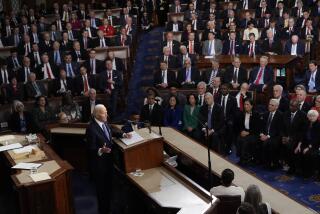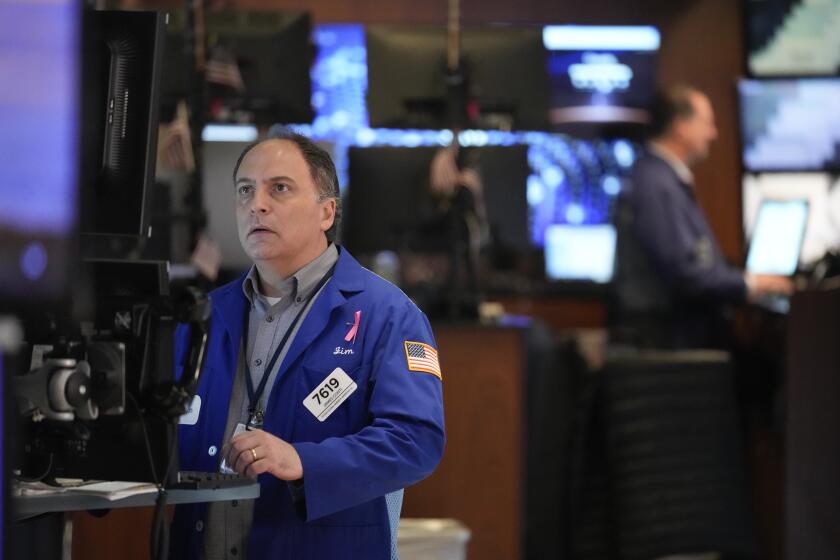State’s Recovery Steadies; U.S. Jobless Rate Up
California’s modest recovery stayed on track last month as the state gained another 17,000 jobs despite a national economic slowdown that nudged the U.S. unemployment rate up to 5.5% in March from 5.4% in February, the government reported Friday.
With its latest employment gains, California this year is adding jobs at a pace nearly 75% faster than in 1994. California’s jobless rate also edged up in March, to 7.6% from 7.3% the month before, but analysts attributed that increase largely to rain-related disruptions in scattered industries.
“Nationally, there’s definitely evidence of an economic slowdown,” said Ted Gibson, economist with the California Department of Finance. But, he added: “We’ve kind of thought all along that California would weather a national slowdown, and so far we’re seeing that this year.”
The U.S. figures showed employers across the country adding 203,000 jobs to their payrolls in March, down roughly 100,000 from the average monthly gains over the last 12 months.
On Wall Street, bond prices finished the day down and stocks were mixed, with the Dow Jones industrial average off 12.79 to close at 4,192.62. The markets were up early in the day, apparently in the belief that the lower-than-expected job gains would keep inflation under control. But they reversed course later amid worries about the sagging U.S. dollar and the prospect of a new recession.
Still, most analysts said the U.S. economy seems headed for the so-called soft landing sought by Federal Reserve Board Chairman Alan Greenspan, who has engineered seven increases in interest rates since early last year to head off inflation. The March jobs figures reinforced the outlook for that type of moderate growth.
“We have hit a glide pattern that is bringing steady job growth without inflation at a relatively low level of unemployment,” said Labor Secretary Robert B. Reich. “We haven’t had this good a combination of job growth and non-inflation for several decades.”
Private economists generally were upbeat too. “We do not have the growth we had last year, but we have achieved a soft landing,” said Gordon Richards, chief economist for the National Assn. of Manufacturers.
Despite the rise in the national jobless rate, “I don’t see any reason to worry,” said Barry Rogstad, president of the American Business Conference, an organization of 100 fast-growing firms.
“You’ve got an economy here that shows some real depth and resiliency. One month is not significant. If you see the increase happening three and four months in a row, then you have some concern.”
But Dean Baker, an economist with the labor-supported Economic Policy Institute, already saw cause for concern: Average hourly wages were up only 2 cents an hour over the last two months, to $11.33.
*
Wage growth has been weak for years, Baker noted, and with the job market already slowing down, “it’s unlikely workers will be able to make up for lost ground.” Over the last 12 months, hourly wages were up 2.8%.
Baker also noted that many of March’s job gains came in construction, which he said could be a one-month aberration because of unseasonably warm weather in much of the country. If construction employment cools off, and no other sector picks up the slack, he said, “then things might be weaker than Greenspan is looking for.” The only industry posting bigger job gains than construction was the service sector, which was up 133,000.
Also voicing concern about the job market was Rep. Pete Stark (D-Hayward), a member of the Joint Economic Committee, who said he would favor lower interest rates to stimulate home building and other construction.
Newspapers are filled with want ads for computer programmers and others working in high-tech fields, he said, “but in my district the union halls are packed with carpenters and plasterers and laborers,” who aren’t working because the construction business is slow.
In another worrisome sign, manufacturing employment dipped by 4,000, the first decline in that sector since the end of 1993.
Among the 11 big states whose jobless rates were reported Friday, California continued to show the highest unemployment. Next came New York, at 6.6%, followed by both Michigan and Pennsylvania, at 6%.
Ohio posted the lowest jobless rate, 3.8%, followed by North Carolina, at 3.9%, and both Florida and Illinois, at 4.4%.
Some analysts express confidence that California’s economy, which was far slower than the rest of the nation to pull out of recession, now has considerable momentum despite signs of softness nationally.
Gibson, the state finance department economist, said the national downturn may even help California by pushing down interest rates and reinvigorating the state’s struggling construction industry. He said California’s export industries also stand to benefit from the weakness of the U.S. dollar against the Japanese yen and the German mark.
In addition, Gibson predicted, “pent-up demand” for homes and appliances should help power the state’s long-struggling economy.
In March, the state’s job gains were spread across various industries, led by a 18,500 increase in services. But the construction industry, hurt by March rains that were particularly heavy in Northern California, lost 6,900 jobs.
Agriculture--an industry whose employment is so volatile that analysts ordinarily look at it apart from the rest of the economy--suffered a loss of 14,700 jobs that also was largely attributed to the bad weather.
All told, the state figures “paint a picture of a broad-based recovery. We’re even getting some new jobs in manufacturing,” said Tom Lieser, associate director of the UCLA Business Forecast Project.
Analysts termed the three-tenths of a percentage point increase in the state’s jobless rate--from a four-year low of 7.3% in February--as insignificant. They said part of the rise was because of bad weather, but they also characterized the relatively small survey from which the jobless rate is computed as less reliable statistically than the separate poll of employer payrolls that showed the 17,000 gain in jobs.
Los Angeles County’s jobless rate--which, unlike the national and state figures, is not adjusted for seasonal trends--inched up to 8% in March, from 7.9% in February. Still, the county’s volatile rate remains down from 8.9% in January.
During March, the number of unemployed in the county rose by 2,000 to 348,000 while employment fell 45,000 to 3,983,000.
Silverstein reported from Los Angeles and Rosenblatt from Washington.
(BEGIN TEXT OF INFOBOX / INFOGRAPHIC)
Unemployment Rate:
March 1995: 5.5%






